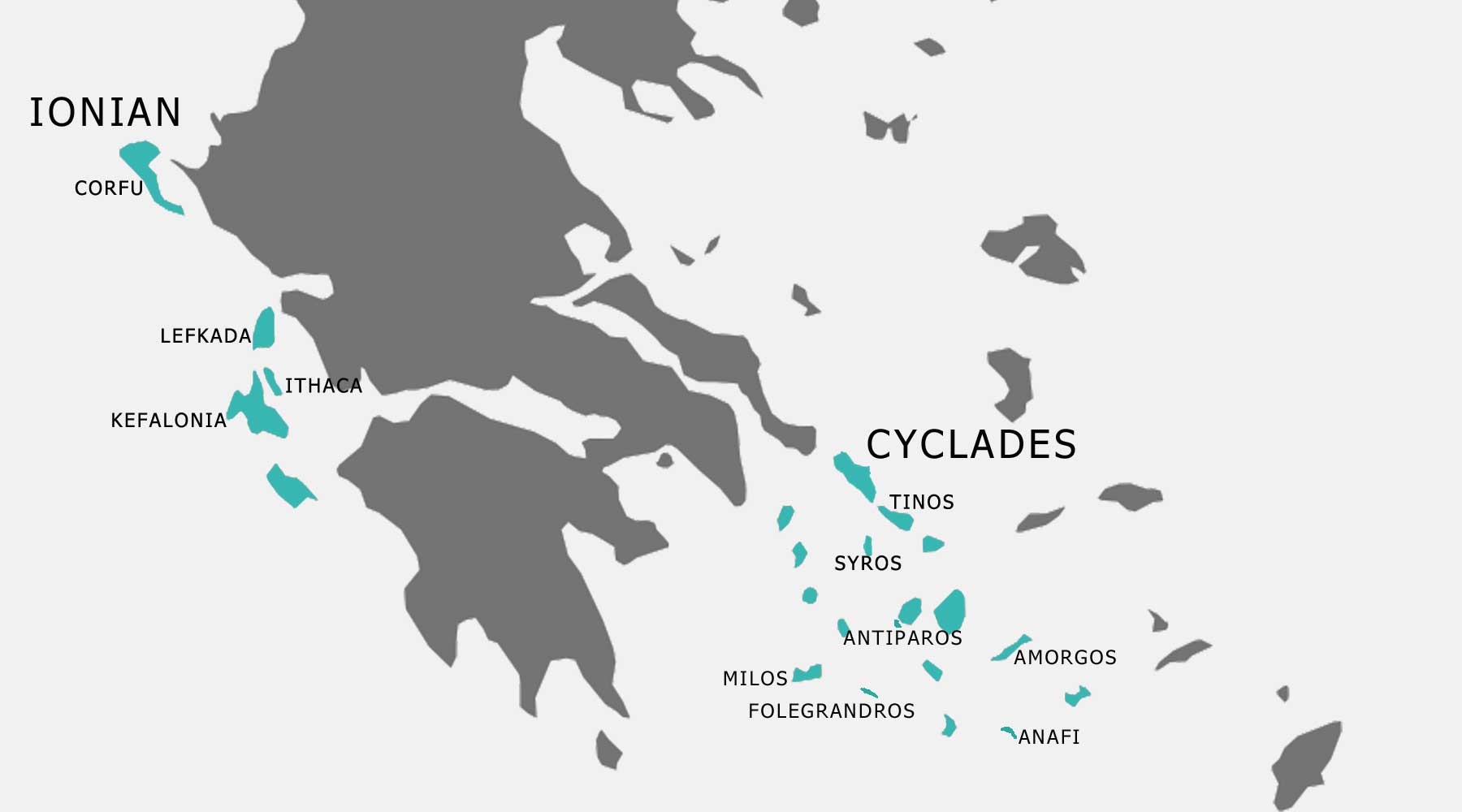The Greek Islands: Cyclades and Ionian
The spirit of the Greek Archipelago is unequalled: sun-kissed beaches with crystalline waters, mountainous villages with traditional character, distinct cultural and archaeological monuments and the endless blue of the Aegean Sea.
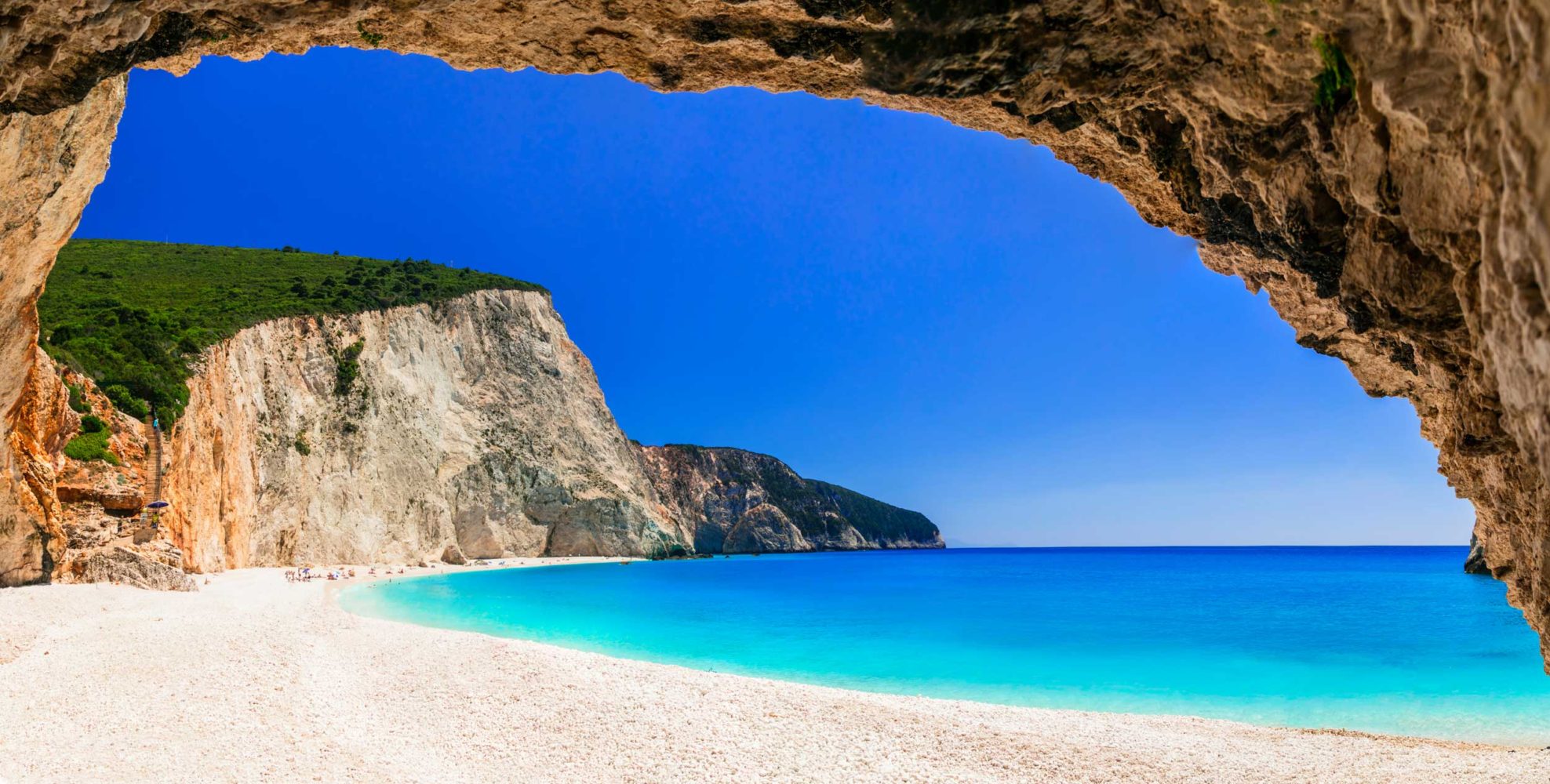
Scattered pieces of land bestowed upon the waves by the Olympian Gods, the Greek Islands comprise 6000 islands of different sizes and shapes, of which only 227 are inhabited. Choosing an island, or islands, to visit can take weeks of research; here, we outline the character of the Cyclades and Ionian Islands — with detail on the most interesting island destinations — which will be a helpful starting point for those planning a trip. For the other islands, read The Greek Islands: Dodecanese and Northeast Aegean.
Cyclades Islands
Amorgos | Anafi | Antiparos | Folegandros | Milos | Syros | Tinos
Ionian Islands
Corfu | Ithaca | Kefalonia | Lefkada
Cyclades Islands
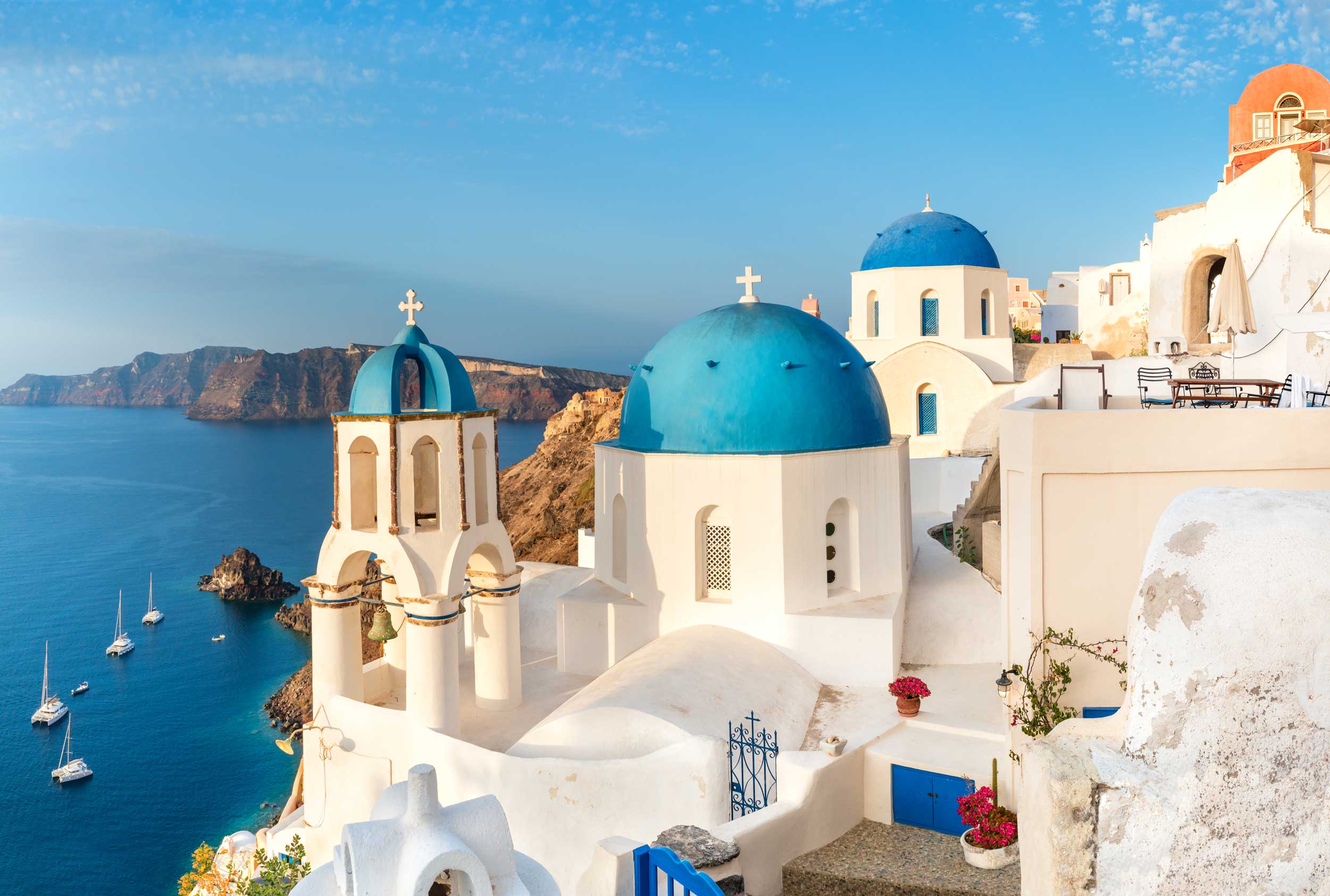
Entrancing with golden sand and sparkling waters, the islands of the Cyclades are the most popular islands of the Greek archipelago.
Overview: The Cyclades islands are the most popular island group in Greece. Mykonos, the island of the winds, has an inexplicable beauty and vibrant nightlife, while the volcanic island of Santorini is home to the most beautiful sunsets and its satellite isle, Anafi, hosts the second largest monolithic rock after Gibraltar. Syros, crowned as the capital of the Cyclades, offers neoclassical charm, and Kea, with its underwater treasures, is home to the shipwreck of the HMHS Britannic.
Kythnos proudly boasts the only thermal springs in the Cyclades, Sikinos has a reputation for its residents’ kind hospitality, Naxos is more traditional in character, and the unknown islands of Amorgos and Tinos are quietly religious. Andros, Kimolos, Serifos and Sifnos are authentically Greek, and the seas around unspoiled Antiparos hold emerald seashores. Folegandros and Milos are both romantic compared with the original hippie and party island of Ios, while the serene Lesser Cyclades islands — Donousa, Heraklia, Koufonisia, and Schinoussa — distinguished by their calm atmospheres, and Delos (the UNESCO World Heritage site and religious center of Ancient Greece) rounds off the group.
Landscape: Rocky landscapes, distinctive white and blue cuboid architecture, magnificent golden beaches, picturesque windmills and hospitable people.
Best for: Nature lovers who appreciate unspoiled scenery, families and honeymooners, or young people seeking a party destination.
Budget: Accommodation offered in the Cyclades varies, including a great assortment of rental rooms and studios, boutique hotels, elegant villas and luxurious resorts. Airbnb is very popular in the Cyclades while several islands offer wellness and yoga retreats such as Amorgos, Folegandros, Kythnos, Mykonos, Paros and Syros.
Postcard Image: Enjoying the sunset from the picturesque harbour of Little Venice in Mykonos.
Amorgos
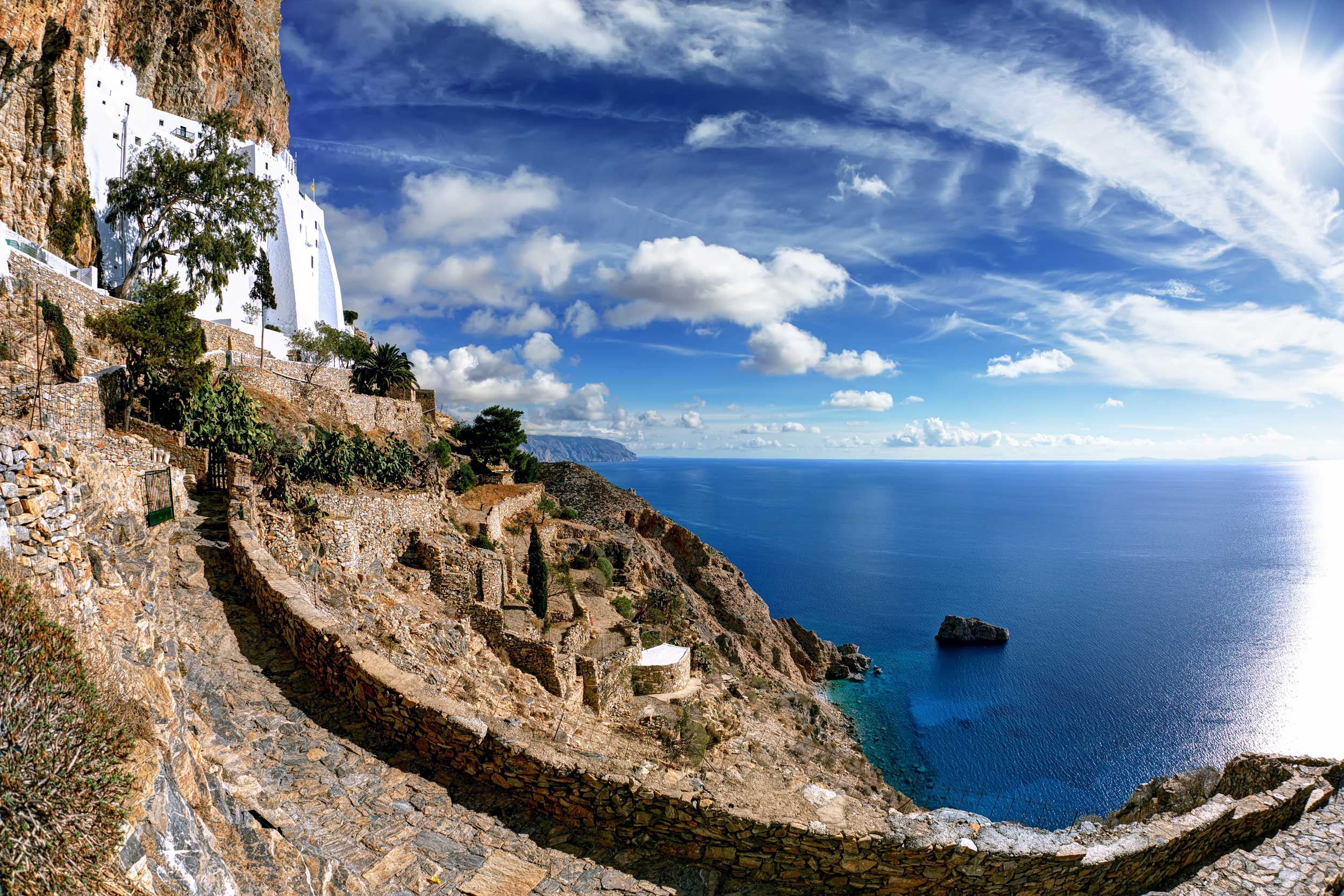
Why go: Amorgos is one of the most authentic Greek islands of the Cyclades, with dramatic and mountainous topography. Perched on a rock, the Monastery of Panagia Hozoviotissa, one of the most beautiful monasteries of the Aegean, is a key attraction. Explorers will enjoy a boat trip to the deserted islands of Gramvousa and Nikouria, while hikers can experience wonderful eco trekking trails that reveal the best of Amorgos. Seven old trails snake between the villages, which locals used to get from one village to another until the 1980s. The varied coastline of this island makes it popular with scuba divers.
Travel tip: This Island is famous for the traditional liquor of rakomelo. Its ingredients include alcohol distilled from grapes, known as raki, honey and various herbs. It is quite often enjoyed with a cinnamon stick.
Anafi

Why go: Isolated at the edge of the Cyclades, Anafi is one of the most pristine islands of the Aegean. The old monastery of Panagia Kalamiotissa is perched on the highest peak of the imposing monolithic limestone Rock of Kalamos, considered to be the second highest in the Mediterranean only after Gibraltar. It is an important area for native bird species under NATURA 2000, the European conservation program with the largest coordinated network of protected areas in the world. Visitors can spend the day climbing to the top of 450-metre-high Kalamos following the ‘Argonaut Expedition’ trail that ascends the rock, where visitors can see the sun rise over the Eastern Mediterranean. Up to seven hours are needed to ascend to the top while the descent is easy through a well-designated path passing by the monastery. Rent a boat from the harbour for a 10-minute sail to get to the Rock. Beach lovers should head to the sands of Flamorou, Roukounas and Megas Potamos.
Travel tip: Every August, the Yakinthia sports competition draws a lot of attention on the island. In antiquity, the festival was held in honor of the god Apollo, hence the name of the statue, Apollo Aiglitis, that was found on the island and which is now exhibited in the British Museum. Anafiots continue this sporting tradition today.
Antiparos
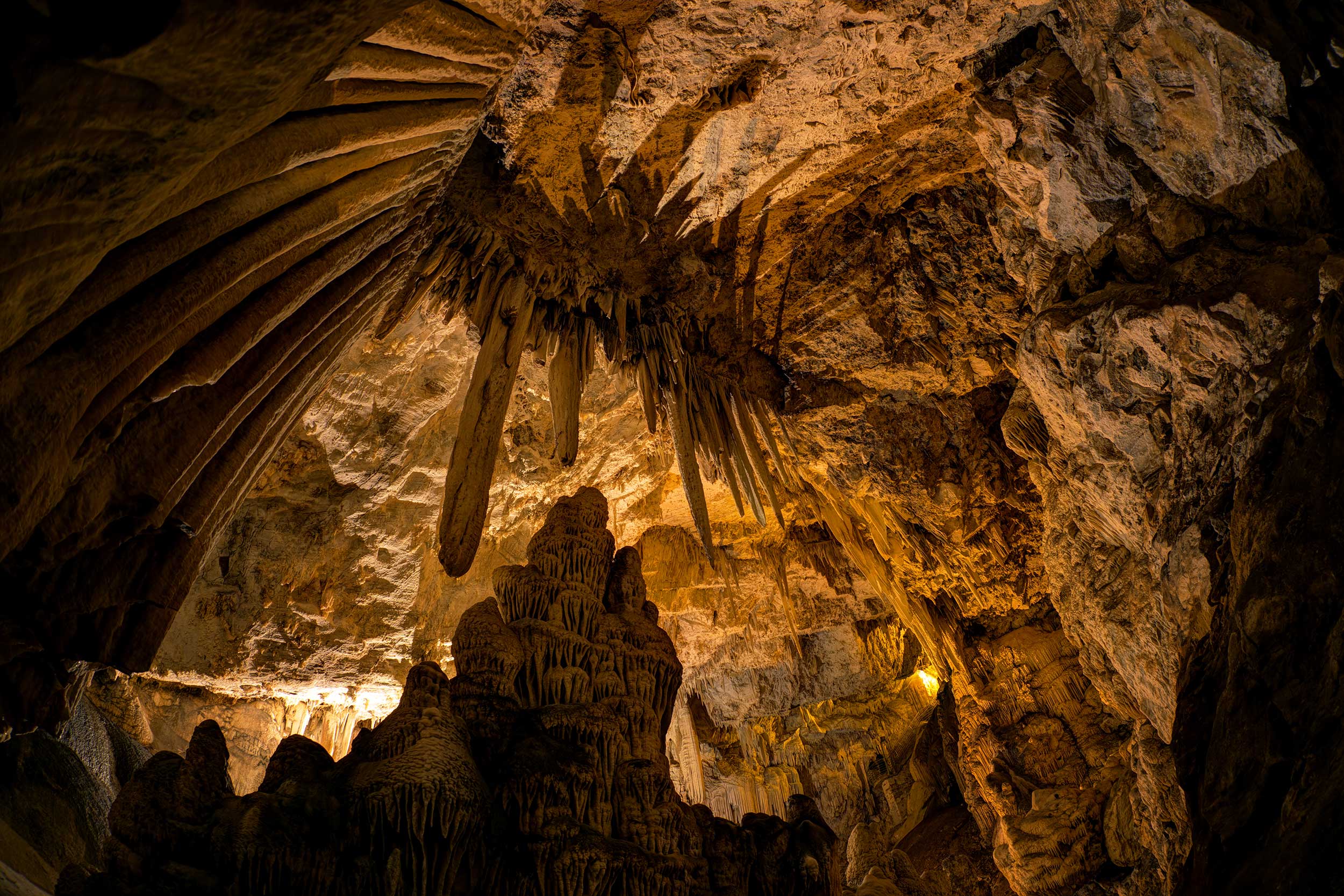
Why go: Antiparos is a small dot on the Cyclades’ map. This tiny island is known for its unique natural wonder, the Cave of Antiparos, which is considered one of the oldest caves in Europe. Antiparos has some of the most beautiful beaches of the Cyclades including Faneromeni, Monastiria and Soros. Rib cruisers and sailing enthusiasts should visit the isle of Despotiko to play in its turquoise waters. The chapel of Prophet Elias stands at the highest spot on the island and the road leading to it is popular with mountain bikers. Taking a stroll in the charming (and sole) village of Antiparos is a pleasant way for visitors to spend the evenings.
Travel tip: Antiparos is known for the revival of the Klidonas’ old tradition, which takes place on June 23 and 24. Tradition has it that local men used to gather at Hora, sit around a fire, and sing traditional songs while young girls used to gather and sit around a pot, where they hid objects marked with the names of the men. The first name a girl found would be the name of their future husband.
Folegandros

Why go: The main village of Chora is an exemplar of the Cyclades’ traditional style of architecture. The oldest part of the village, known as Kastro, is a fortified medieval settlement with some houses being 1000 years old, and still inhabited. From the village, one can visit the church of Panagia built on a rocky hill with astonishing views to the Aegean. It’s possible to take a traditional boat to visit Katergo, the island’s most attractive beach, or to dive along the Folegandros coastline sites such as the cave of Georgitsis and the reef of Serfiotiko.
Travel tip: Shortly before the beginning of the Holy Week of Easter, the locals ensure that their houses are spotlessly clean, as the holy icon of Virgin Mary passes through every single house of the island. The procession of the icon lasts three days and enters all of the houses of Folegandros along with the procession of pilgrims, to bless the house.
Milos
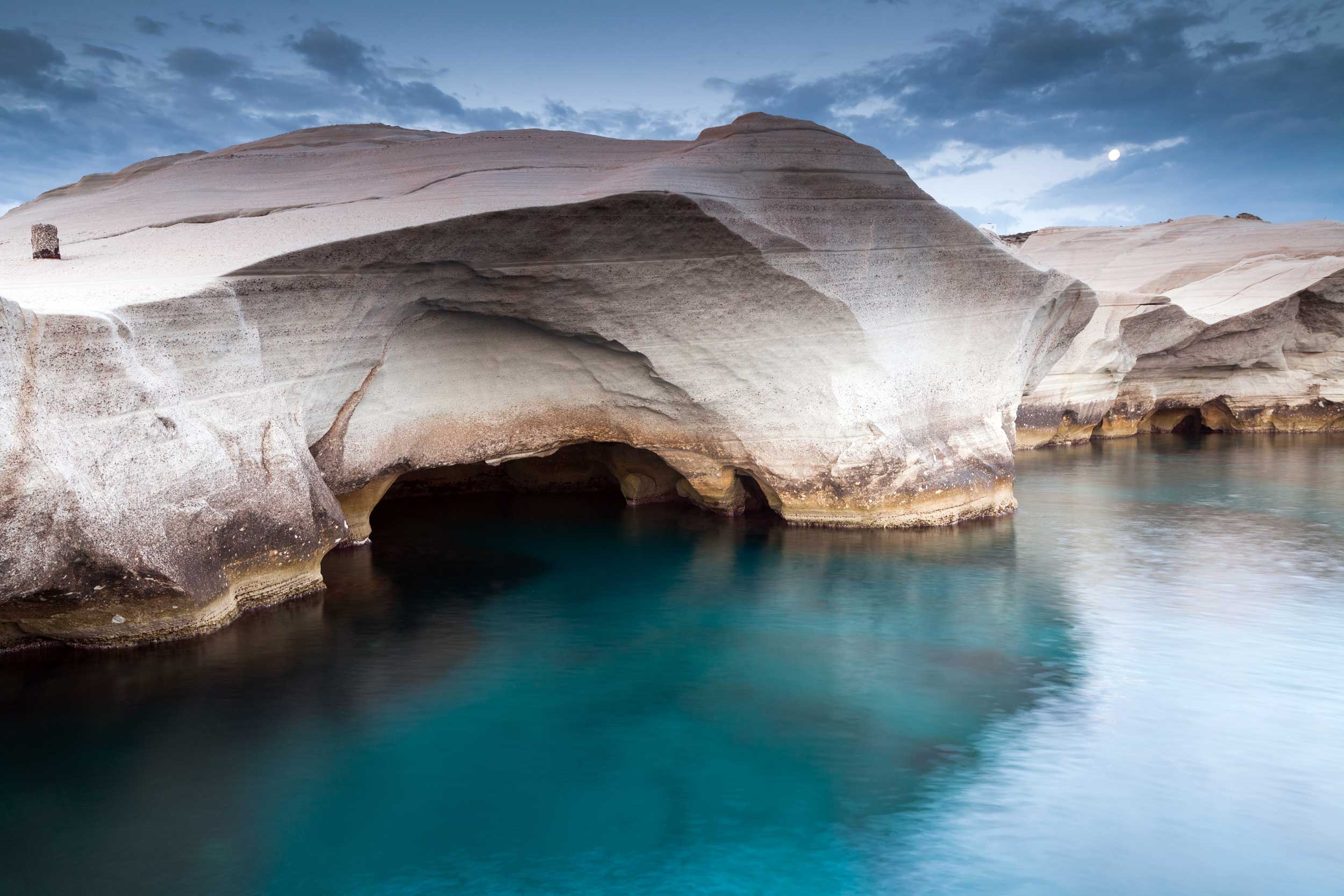
Why go: The island of Milos was formed around three million years ago as a result of volcanic activity, which is apparent in the lunar landscape of Sarakiniko with its smooth rocks and underwater caves. The capital of the island, Plaka, is the island’s most attractive settlement, complete with a medieval castle, and the nearby Catacombs of Milos considered to be one of the most ancient monuments of Christianity. The Milos Mining Museum, dedicated to the mining history of Milos will appeal to those interested in the island’s unique geological history. The caves of Kleftiko at the southwest tip of the island, formed by wind and water erosion, are best visited by boat.
Travel tip: A sweet-smelling watermelon pie is a typical dessert of the island.
Syros
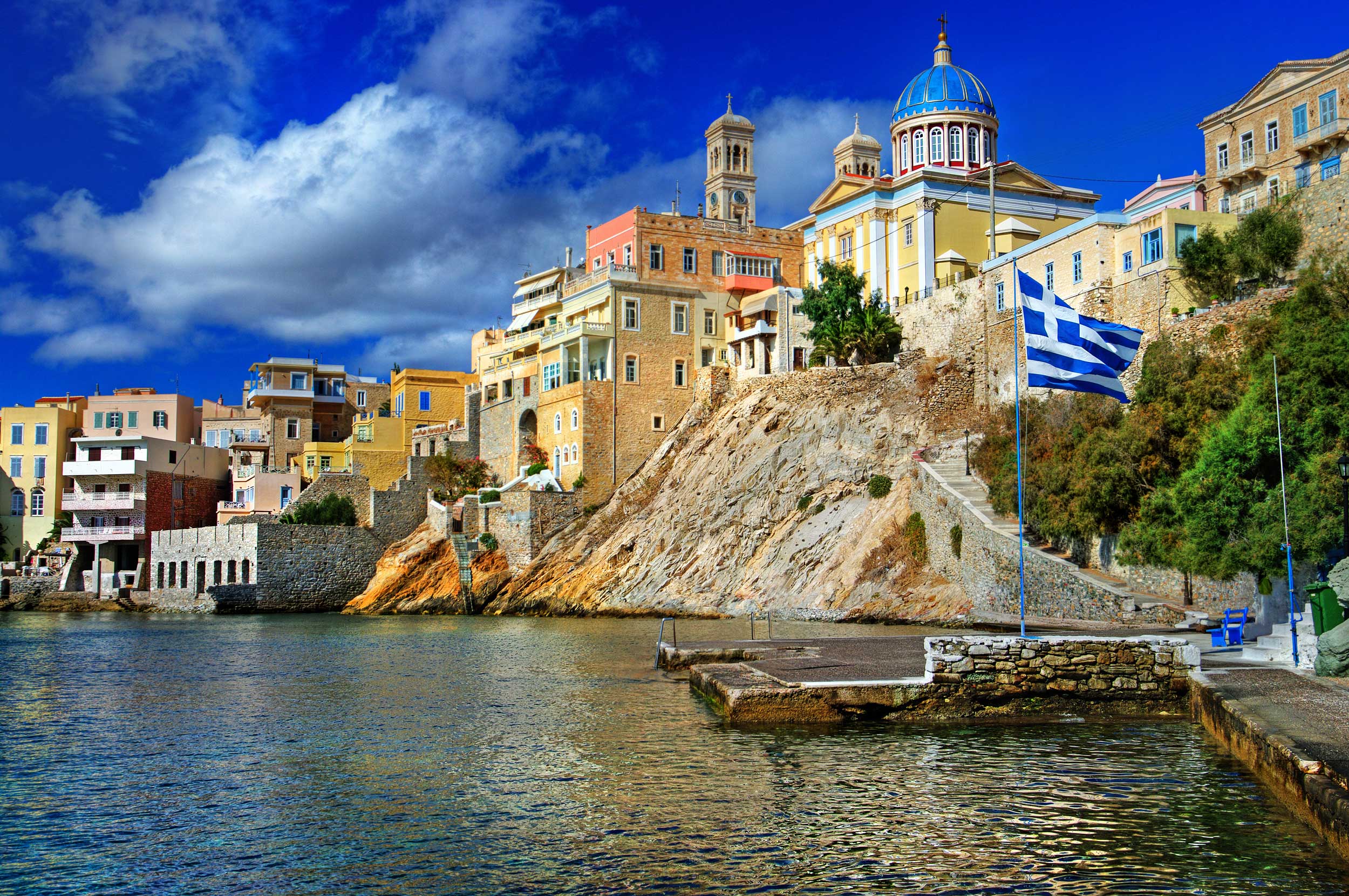
Why go: Syros is proudly crowned the capital of the Cyclades, rich in history and medieval charm. The privileged location of Syros — in the very centre of the island group — make it an easily accessible destination. The magnificent city of Hermoupolis, which resembles an open-air museum of neoclassical architecture, the medieval quarter of Ano Syros and the ancient monuments of Kastri make Syros appealing to visitors who enjoy classical history.
Travel tip: Visitors should try Syros’s famous loukoumi, which is made of water, starch and sugar, and is available in flavours including mastic, rose, bergamot and coconut. These Turkish delights have their roots in Asia Minor, as they first appeared on the island around 1832 with the arrival of refugees from Chios.
Tinos
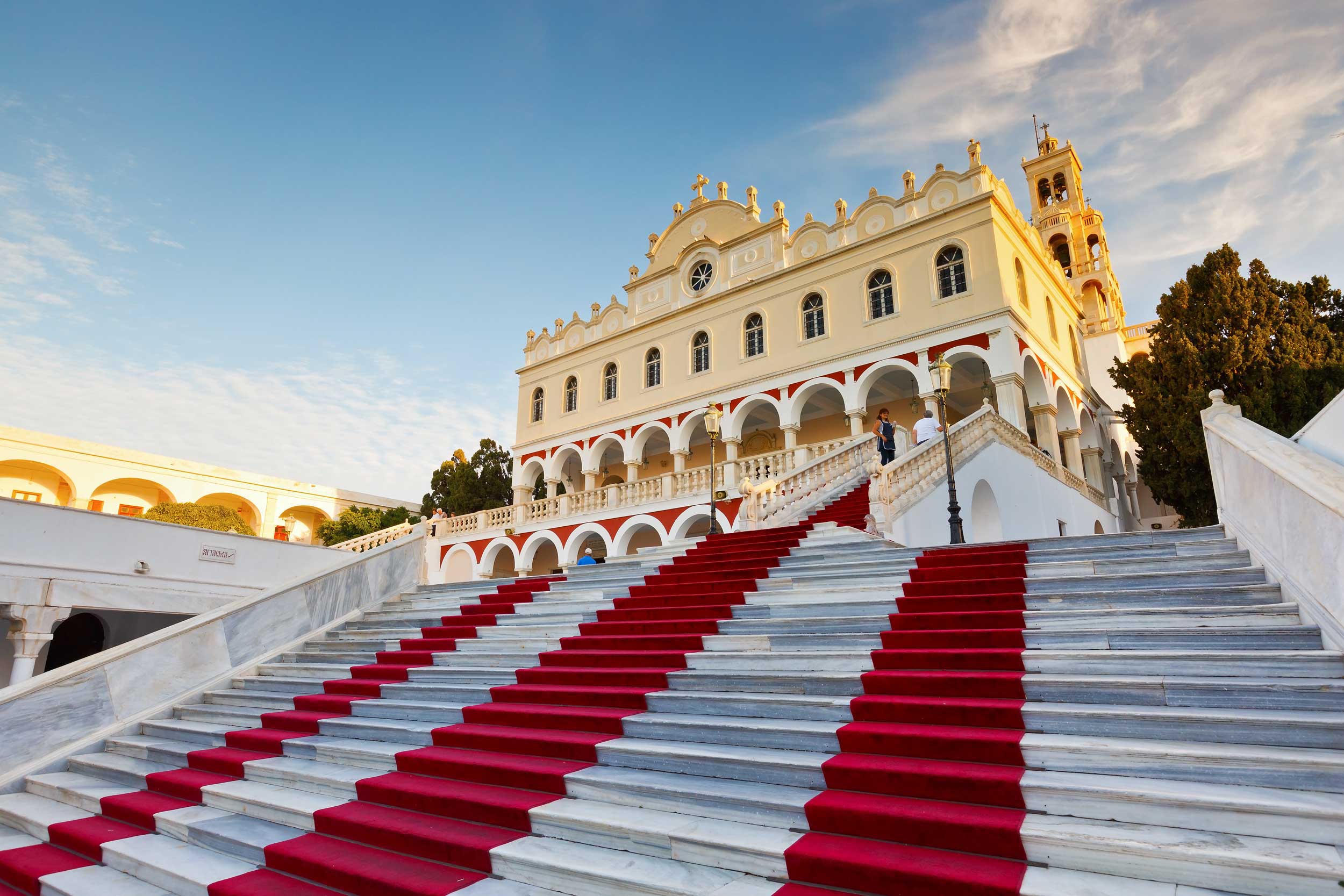
Why go: Each year, on August 15, Christian pilgrims travel to Tinos to pay respect to a miraculous icon of the Virgin Mary at the church of Panagia Evangelistria — the largest pilgrimage in Greece. The island comprises several traditional villages: Hysternia and Pyrgos, with their rich marble crafting tradition; Kardiani with its verdant sceneries; Volax with its huge granite boulder formations; and Dyo Horia and Triantaros with their panoramic views of the Aegean Sea. The island is one of the best destinations for windsurfing.
Travel tip: Tinos was once one of the most popular marble processing centres in Greece. The Marble Crafts Museum in Pyrgos village showcases the island’s rich history of marble craft.
Ionian Islands
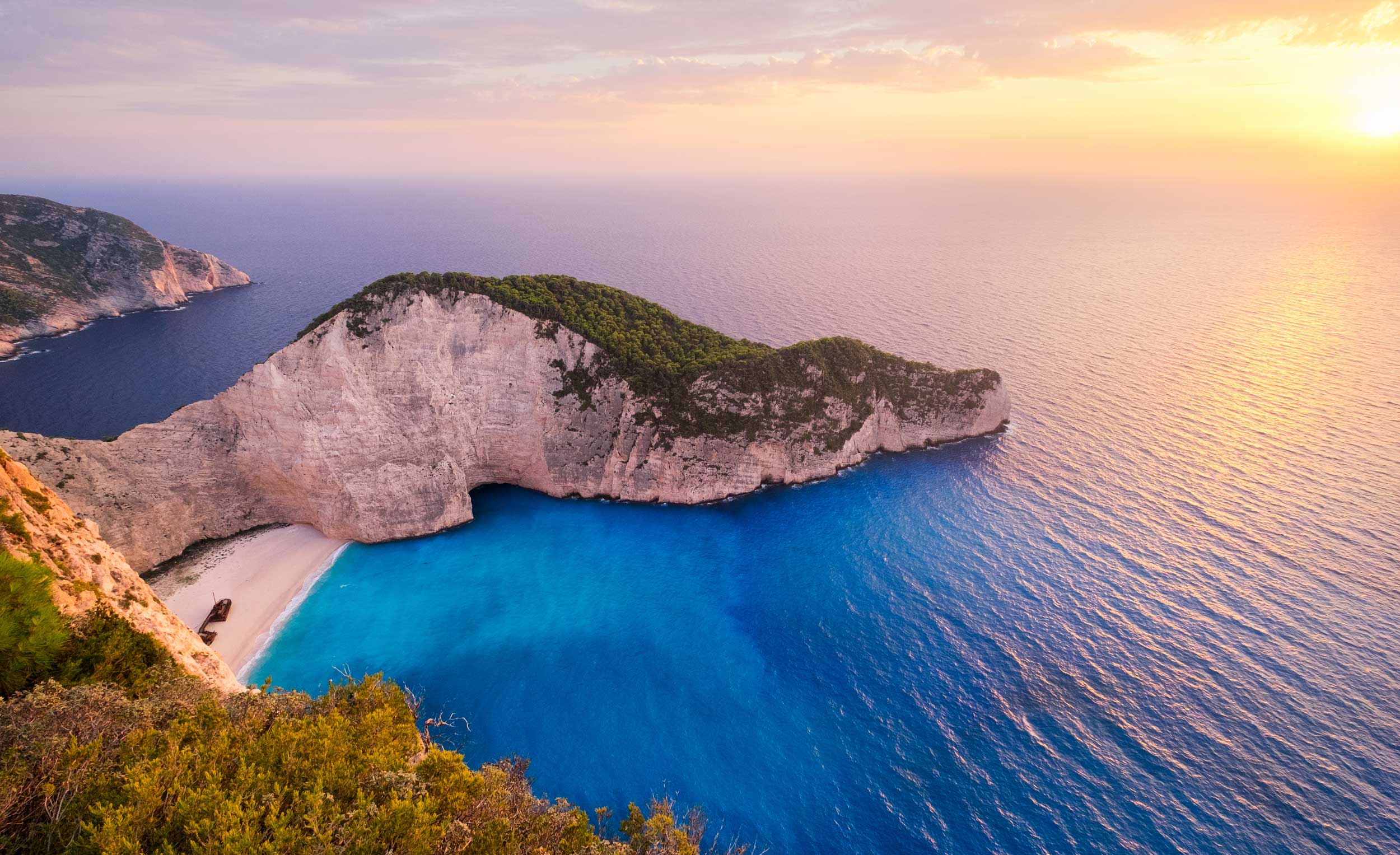
Distinguishable for their sense of cultural finesse, lush vegetation and their sparkling waters, the islands of the Ionian Sea have acted as the muse for several movies and works of literature.
Overview: Long popular with British holidaymakers, the UNESCO World Heritage island of Corfu retains echoes of Byzantine splendor. Known as the Flower of the East, the beauty of Zakynthos, with its mystical sea caves, is inexhaustible. The entire island of Kefalonia is painted in striking shades of blue and green while Ithaca is a symbol of love and nostalgia rendered immortal through the tales of Homer’s Odyssey. Paxi is another lovely island in the Ionian Sea, rumoured to have been a refuge for Anthony and Cleopatra in 31 B.C. Lefkada is where the blue of the Ionian Sea meets the evergreen forests and Kythera, the outsider of the Ionian, is the utopia of desire and symbolism for great intellectuals and renaissance artists. Of course, one cannot forget the tiny isles of the Ionians; Mathraki and Meganisi with their verdant vegetation, Othoni with its mountainous scenery, Erikoussa with its rich tradition of olive growing, Kastos with its tranquil atmosphere and Kalamos with its wild beauty.
Landscape: Gifted with a cooler climate than the Cyclades Islands, the contrasting landscape of the Ionian Islands ranges from impressive coastlines hosting some of the finest beaches in Greece to forested mountains and landscapes abundant with olive and cypress trees.
Best for: Sailing voyages, family escapes, gastronomy experiences, romantic getaways, diving expeditions and nature explorations. The Ionian Islands are about escapism and tranquility.
Budget: Options hover around the reasonable mid-range, mostly comprising boutique hotels, traditional studios and rooms to let. Nonetheless, there are some luxury, and at times all-inclusive, resorts in Corfu, Kefalonia and Zakynthos.
Postcard Image: Taking in the view of the Ionian Sea standing by the shipwreck of the MV Panagiotis at Smuggler’s Cove on the island of Zakynthos.
Corfu
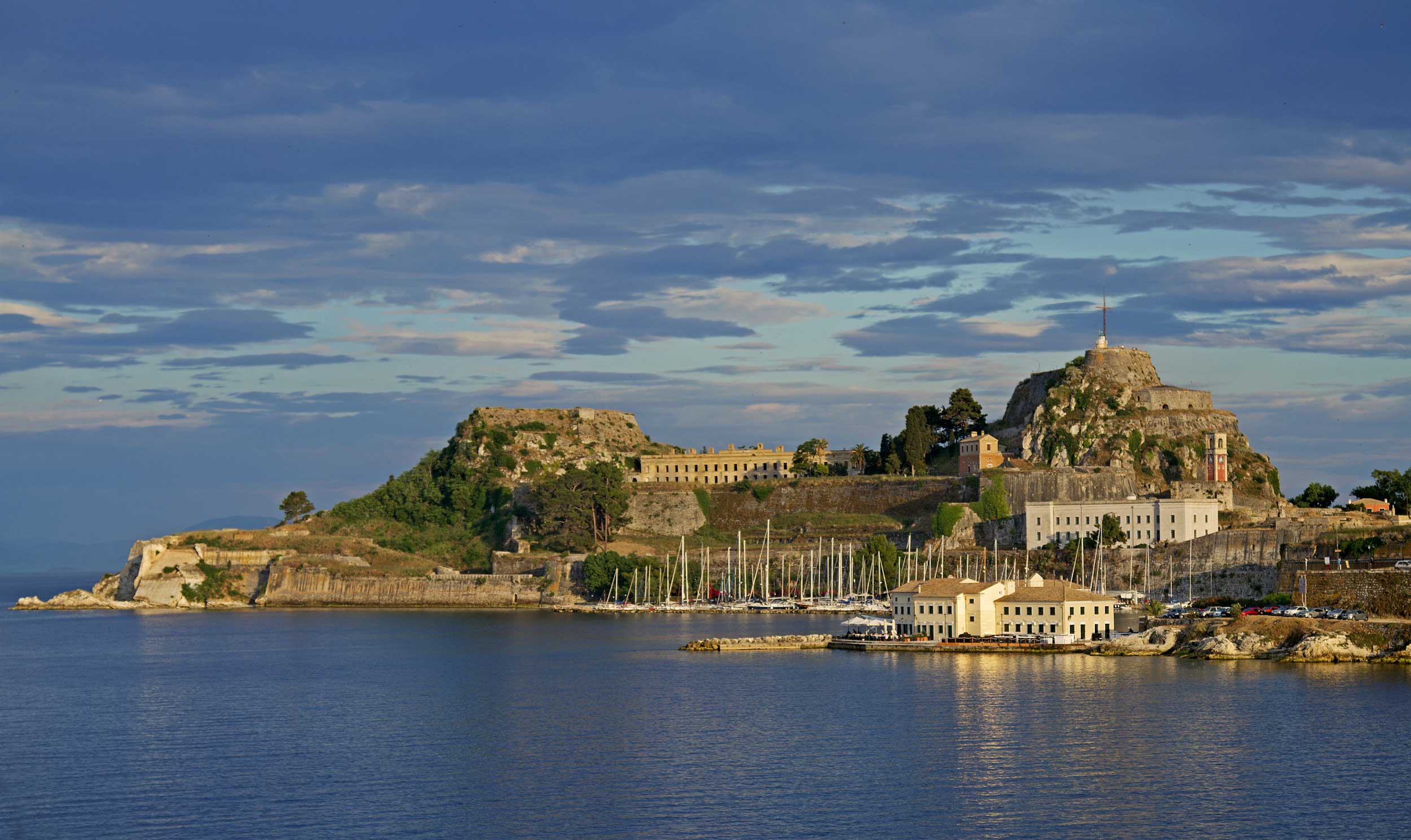
Why go: A UNESCO World Heritage Site, the town of Corfu showcases a unique patchwork of European influences beginning with Spiniada Square, which was built in the style of the royal gardens of Europe. The town’s rich monuments include the Achillion Palace, once the residence of Austria’s Empress, the imposing Old Fortress, and the Royal Palace, which was built by the British Lord Commissioner of the Ionian Islands. Liston Square was inspired by the design of Rue Rivoli in Paris, and Corfu’s Town Hall is an impressive building of Venetian architecture. Nature lovers should visit the Canal d’Amour, a sandy cove with beautifully clear waters, Pondikonissi Isle — the final destination of Odyssey’s mythical journey — and Palia Perithia, a deserted village that the State of Greece has declared a protected settlement. Good times to visit Corfu are Easter — to join in with local traditions and enjoy opera concerts — and February/March for the annual Carnival of Corfu, a street party that began as a result of the Venetian occupation of the island in the 14th century.
Travel tip: The Corfu kumquat is one of the finest fruits cultivated in Greece. It grows on the northwest tip of the island and has been awarded with a Protected Designation of Origin by the European Union.
Ithaca
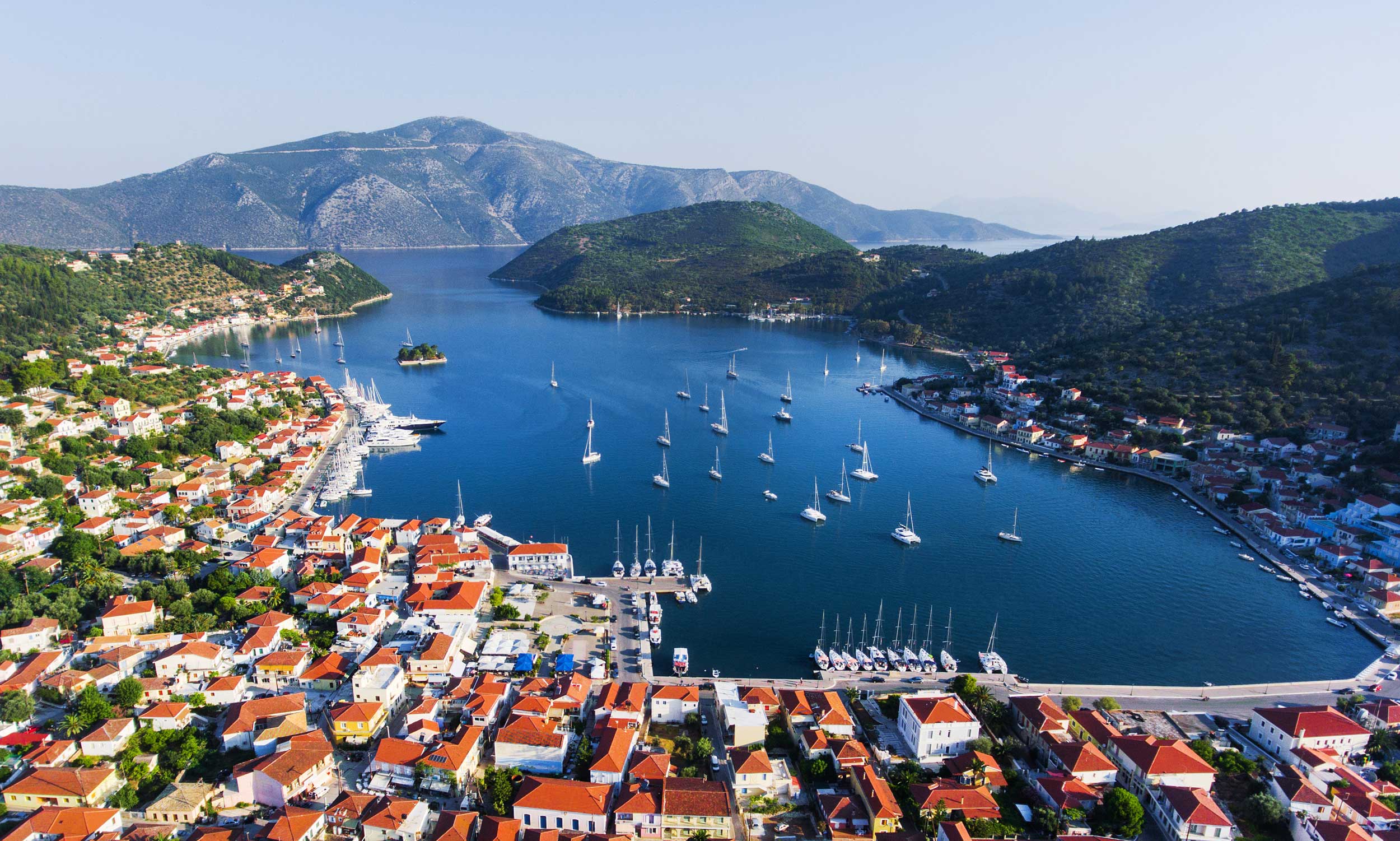
Why go: Vathy, the capital of romantic and mysterious Ithaca, is a traditional settlement with one of Greece’s safest natural harbours, which attracts thousands of sailing enthusiasts every year. The nearby stalactite-rich Cave of Nymphs is believed to be the cave depicted in Homer’s Odyssey. Other attractions include the Monastery of Panagia Kathariotissa, the patron saint of Ithaca, and the Acropolis of Alalcomenae, which was believed to be the palace of Odysseus. Kioni village is a lovely settlement with traditional character and Platia Ammos, Filiatro, Gidaki and Frikes are good, clean beaches. Divers can enjoy numerous diving sites in Ithaca including the cave of Oksopetra, the cape of Gidaki and the rocks of Aphales.
Travel tip: Ithaca has a rich musical tradition that dates back to the Venetian times. The Philharmonic School of Ithaca was founded in 1904 with the intention of providing a broader musical education to the inhabitants. Its orchestra participates in all of the island’s events.
Kefalonia
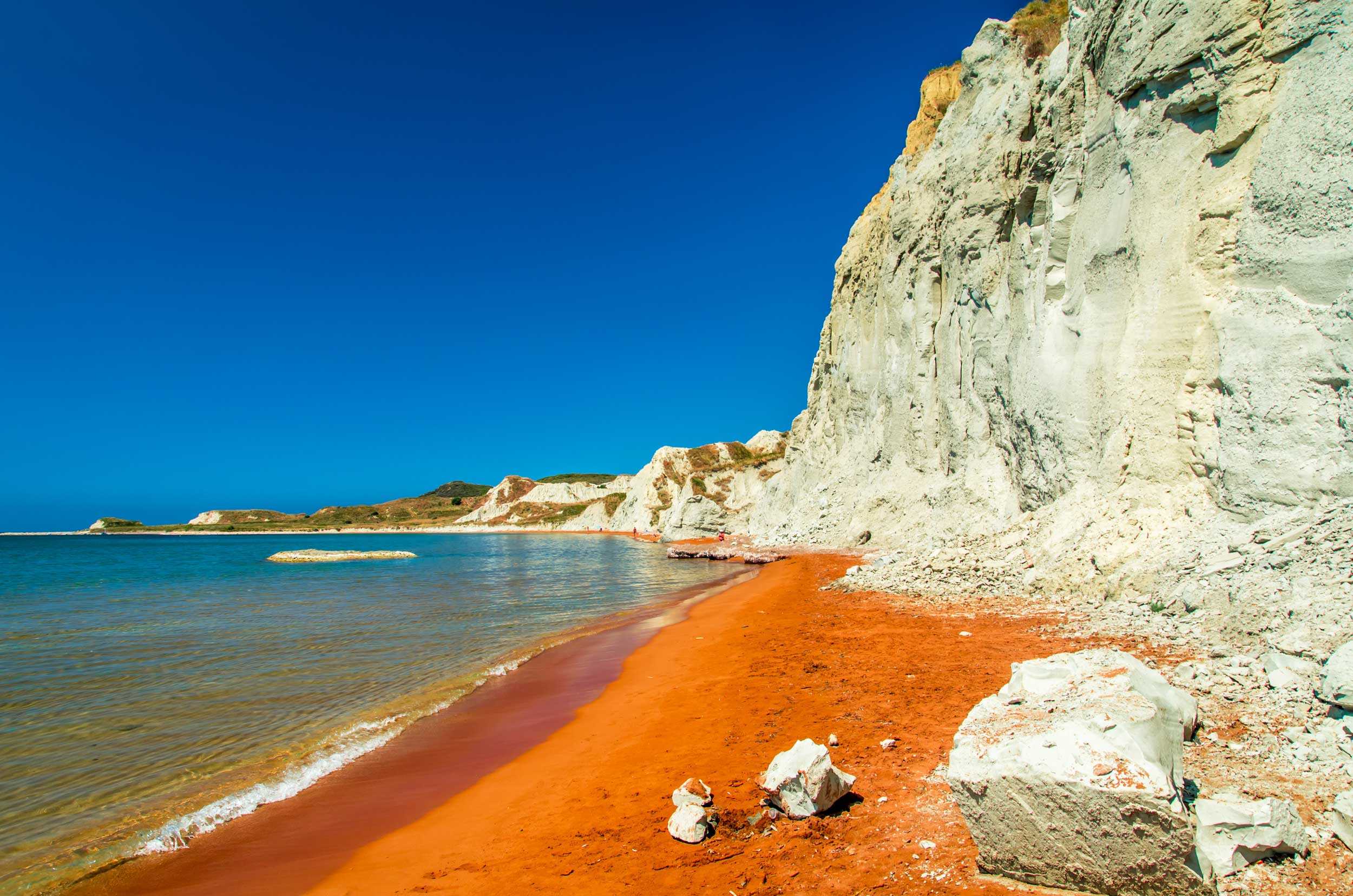
Why go: Kefalonia is home to some of the most beautiful beaches in the Ionian Sea: exotic and popular Myrtos, Platia Ammos and Petani with their wild scenery, and Xi for its red sand. Melissani Cave is an underwater lake with successive chambers, a true geological phenomenon. Aenos National Park houses the heart of Kefalonia’s biodiversity; what is so special about it is the endemic and genetically pure species of fir called Abies Cephalonica, which grows at altitudes of 600 to 1600 meters. Assos and Firskardo villages have a traditional and romantic character. Kefalonia is ideal for those interested in an active holiday involving hiking, mountain biking, kayaking and sailing.
Travel tip: Kefalonia has a long tradition of winemaking that dates back to Neolithic times. There are approximately 48 grape varieties grown on the island, the most famous being Robola, which is specific to Kefalonia. The white wine, Robola of Kefalonia is produced exclusively in Kefalonia.
Lefkada

Why go: Porto Katsiki with its dramatic cliffs, and Kathisma and Egremni with their crystalline waters, are testament to Lefkada having some of the finest beaches in the Mediterranean. The island’s charm is found in its villages: traditional Agios Nikitas, authentic Eglouvi, and Nidri with its natural bay are some of the most beautiful. Adventurers should visit the tiny islands of Kastos, Kalamos and Meganisi while bird-watching enthusiasts will have the opportunity to encounter a series of native and endangered bird species at the Lagoon of Lefkada, protected by NATURA 2000. In recent times Lefkada has become a hot spot for kitesurfing. It is worth mentioning that the Ionian Regatta, one of the biggest yachting events in the Mediterranean, takes place on the island every September.
Travel tip: Eglouvi village is known for its excellent quality lentils. They are considered to be the best lentils in the world, having been grown in the same way from generation to generation. On August 7, the Lentil Festival takes place at the church of Agios Donatos in the village of Eglouvi.
